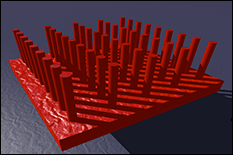UMD Researchers’ New Nanoscale Solar Cells Could Revolutionize Solar Industry
UMD Researchers’ New Nanoscale Solar Cells Could Revolutionize Solar Industry

Assistant Professor Jeremy Munday (ECE/IREAP) and electrical and computer engineering graduate students Yunlu Xu and Tao Gong have designed a new type of nanoscale solar cell that they predict could outperform traditional devices by as much as 40%. This new technology could revolutionize the solar industry by allowing for significantly more power generation from a single device by simply making it much smaller.
Xu, Gong, and Munday had their research on the Shockley-Queisser limit for nanostructured solar cells published in Scientific Reports. Scientific Reports is an online, open access journal from the publishers of Nature. The journal publishes scientifically valid primary research from all areas of the natural and clinical sciences.
The Shockley-Queisser limit describes the maximum solar energy conversion efficiency achievable for a particular material and is the standard of comparison for new photovoltaic technologies. For a standard solar cell, this efficiency limit is ~33%. However, recently people have wondered if nanoscale solar cells are also bounded by this limit.
Now Xu, Gong, and Munday have shown that a single-junction nanostructured solar cell has a theoretical maximum efficiency of ~42% under typical solar illumination. This exceeds the efficiency of a traditional planar device but does not exceed the Shockley-Queisser limit for a planar device with optical concentration, e.g. a solar cell using a lens to concentrate the light. The researchers found that nanostructured solar cells offer an important avenue to achieving high efficiency photovoltaic devices through a “built-in optical concentration.” Even when they consider the effects of light scattering in the atmosphere, nanostructured solar cells can achieve 35.5% efficiency with a modest built-in optical concentration of only ~1,000.
As Munday and his team continue to design and fabricate nanoscale solar cells they find the biggest challenge is nano-fabrication. “You start with a solar cell that works well, and then you perform some extreme treatments to structure it on the nanoscale, all without causing any harm,” Munday says. “Luckily, we’ve found a few materials and processes that look promising and have a team of dedicated students determined to make a big impact in solar energy.”
Related Articles:Qu Wins NIST Grant
UMD Researchers Creating First Onboard Fast-Charging System for Electric Vehicles
NSF Funds Novel Research to Create Scalable Wireless Networking, Averting Usage Crisis
Mayergoyz and McAvoy Publish Unique Text on Electric Power Engineering
UMD Wins $5M Phase 2 NSF Convergence Accelerator Award
Espy-Wilson Featured in MIT’s Tech Review
Wu Wins 2015 Signal Processing Society Meritorious Service Award
Leidos Invests in Innovation Partnership with the University of Maryland
University of Maryland Establishes Orbital Debris Research Center
Researchers at UMD, UCONN, and Rice Awarded MURI
September 3, 2015
Prev Next
Connect
Did You Know

UMD is the only major public research university inside the Washington, DC beltway!!
